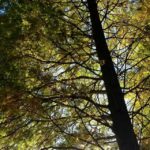November is the time for the first herbicide application to control wild garlic and wild onion, if you have them in your yard.
November #12 (Outdoor)
November #11 (Outdoor)
Keep heavy layers of leaves raked from the lawn. They should be composited. Alternatively, you can mow over a light layer of leaves, turning them to a mulch that adds…
November #10 (Outdoor)
It’s not too late to fertilize your cool-season fescue lawn. Use a turf fertilizer and follow label directions. The fertilizer encourages good root development and helps improve the color of…
November #9 (Outdoor)
Mulch flower beds with 3- to 4-inches of good compost or fine mulch to keep soil temperature stable and prevent winter plant injury from frost heaving. As the compost of…
November #8 (Outdoor)
It’s the ideal time to plant spring-flowering bulbs. Consider planting some of the minor bulbs such as winter aconite, glory of the snow, species tulip, narcissus and grape hyacinths.
Bald is Beautiful, Especially for the Cypress
November #6 (Outdoor)
You can continue to transplant perennials throughout the fall and winter, as long as they remain dormant.
November #5 (Outdoor)
Cut chrysanthemum and other perennials’ stems back close to the ground once they have begun to die back. Leave ornamental grasses to provide winter interest until spring.
November #4 (Outdoor)
Reduce peony botrytis blight and hollyhock rust by removing and disposing all leaves and stems this fall. Roses should have all their leaves raked from beneath to prevent black spot.…
November #3 (Outdoor)
Mulch existing trees and shrubs to help reduce weeds, provide insulation from freezing temperatures, and conserve moisture.
